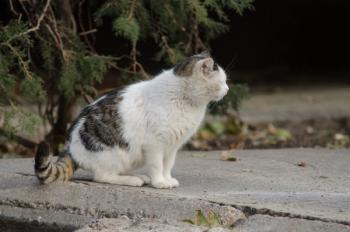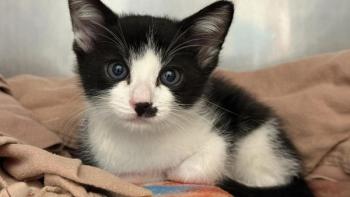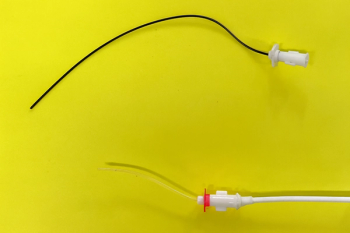
Management of urethral obstruction in cats (Proceedings)
Lower urinary tract disease in cats was described as early as 1925. Over the years, the terms "feline urologic syndrome" (FUS) and "feline lower urinary tract disease" (FLUTD) have been used to describe the group of clinical signs related to problems voiding. However, these descriptive terms do not identify the underlying etiology.
Lower urinary tract disease in cats was described as early as 1925. Over the years, the terms "feline urologic syndrome" (FUS) and "feline lower urinary tract disease" (FLUTD) have been used to describe the group of clinical signs related to problems voiding. However, these descriptive terms do not identify the underlying etiology. The clinical signs of FLUTD are not specific, and may include:
• Pollakiuria
• Dysuria
• Stranguria
• Vocalizing during attempts to urinate
• Hematuria
• Bilateral inguinal alopecia, often with self-excoriation
• Periuria (house soiling)
It is helpful to divide cats with FLUTD into obstructive and non-obstructive uropathy for treatment purposes. Obstructive uropathy is most commonly seen in male cats due to the small diameter of the male urethra. Typical clinical signs include dysuria, hematuria, frequent attempts to urinate, and licking at the penis or prepuce. Some cats will also have signs of systemic illness, such as lethargy and anorexia. Cats suffering from prolonged obstruction may present moribund.
Urethral plugs and urethroliths have been identified as the most common causes of obstruction in male cats1-2. Other potential causes include urethrospasm, trauma, congenital defects, stricture and neoplasia. Since 1980, the frequency of urethral obstructions in cats has been declining, paralleling a similar decline in the frequency of urethral plugs and urethroliths3.
It is currently not known what causes urethral plugs to form. Many urethral plugs are composed of struvite crystals in a proteinaceous matrix. One theory suggests that urethral plugs form in cats with underlying idiopathic cystitis. Plasma proteins enter urine from suburothelial vascular leakage and may trap crystals in the lumen of the urethra, resulting in obstruction. Oozing of plasma proteins into urine combined with active inflammation may increase the urine pH, thus contributing to the precipitation of struvite crystals. Although calcium oxalate uroliths are now at least as common as struvite uroliths, the mineral composition of urethral plugs continues to be predominantly struvite4. Other urethral plugs are composed almost totally of matrix (mucoproteins, albumin, globulins, cells, debris) or sloughed tissue and blood.
Uroliths are organized concretions containing primarily crystalloids with a small amount of organic matrix. The most common components of uroliths are struvite and calcium oxalate4-6 , but recently uroliths composed of dried solidified blood have been reported7. Urine is commonly supersaturated with crystalloids, so crystalluria itself is not a disease and does not need to be treated unless it is associated with clinical signs of FLUTD. Struvite uroliths most commonly occur in the bladder and usually form in sterile urine in the cat. Cats with struvite uroliths are generally younger than cats with calcium oxalate uroliths. Other risk factors include an indoor sedentary lifestyle, obesity, low water intake and alkaline urine. The Himalayan and Persians breeds appear to be predisposed to both types of uroliths.6
Calcium oxalate uroliths have been increasing in frequency in cats since the 1980s as diet manufacturers changed ingredients to promote more acidic urine. By 1993, calcium oxalate uroliths were diagnosed with approximately the same frequency as struvite uroliths, and the prevalence increased in subsequent years. The prevalence of struvite uroliths may have increased from about 2000 to 2004, and then started to decline.6
Calcium oxalate uroliths may be found in the bladder, urethra or kidney and are not usually associated with infection. Cats with calcium oxalate uroliths are generally older and neutered males. Other risk factors include an indoor sedentary lifestyle, obesity, low water intake and feeding acidifying diets. Persian and Himalayan cats appear to be predisposed to this type of urolith as well. Altered calcium metabolism may play a role in calcium oxalate urolithiasis in some cats, so affected cats should be evaluated for hypercalcemia.
Cat with urethral obstruction should be treated as emergencies when presented.8 In particular, cats that have been obstructed 48 hours or more may be severely ill and require crisis management. A thorough assessment of the cat's condition should be made before attempting to relieve the obstruction.
Placement of an IV catheter should be the first procedure in order to administer fluids and medication. Analgesia should be provided at the earliest opportunity. Appropriate agents include butorphanol, buprenorphine, hydromorphone, and fentanyl transdermal patch. Blood samples are collected for a complete blood cell count and serum chemistries/electrolytes. Treatment of the patient can begin before all the results are received. For critically ill cats, an emergency database would be PCV, TP, electrolytes, ionized calcium, blood glucose and BUN. Venous blood gases are also useful if available. Obstructed cats may have moderate to severe dehydration. A balanced electrolyte solution (lactated Ringer's or Plasmalyte) or 0.9% saline is adequate for rehydration and stabilization.8 In severely dehydrated or moribund cats, 20-30 ml/kg may be administered as an initial intravenous bolus.
Common abnormalities in cats with urethral obstruction that may require correction include azotemia, hyperkalemia, metabolic acidosis and hypocalcemia. In one study, about 24% of 199 obstructed cats had mild to severe hyperkalemia (> 6.0 mEq/L)9. About 12% of the cats in the same study had multiple, life-threatening metabolic derangements (particularly hyperkalemia with concurrent hypocalcemia). With severely ill patients, part of the assessment plan should include an ECG (lead II).
In most cases, azotemia, acidosis and hyperkalemia resolve with administration of fluids and relief of the obstruction. Severe acidosis has profound effects on the cardiac, respiratory and central nervous systems. Sodium bicarbonate may be required to resolve severe metabolic acidosis (pH <7.1). If blood gases are not available and metabolic acidosis is suspected, administer 1-2 mEq/kg of sodium bicarbonate slowly. It is important to monitor serum calcium as sodium bicarbonate lowers the ionized portion of plasma calcium and some patients are already hypocalcemic at presentation.
Potassium is involved in cellular function and neuromuscular transmission. Hyperkalemia may have profound cardiac effects, with characteristic ECG changes that include bradycardia, peaking and narrowing of the T wave, a shortened QT interval, widening of the QRS complex, and decreased amplitude or loss of the P wave. It is not possible to correlate the ECG changes with the severity of the hyperkalemia. The effect of hyperkalemia in cats with severe ECG disturbances can be countered with calcium gluconate, which directly antagonizes the high potassium at the cell membrane level. Administer 50-100 mg/kg IV over 2-3 minutes while monitoring the ECG. The effects are almost immediate and will last about 30 minutes.
Plasma potassium can be further decreased if necessary by driving it intracellularly, using regular insulin (0.1-0.25 U/kg IV). The insulin should be followed with an IV bolus of 50% dextrose (0.5 g/kg, diluted) to prevent hypoglycemia. Serum potassium will decrease within 1 hour. Blood glucose should be monitored for several hours after administration of insulin, and fluids can be supplemented with 2-5% dextrose to maintain normoglycemia.
In another study, ionized hypocalcemia (< 2.4 mEq/L) was identified in 75% of 24 obstructed male cats 10, usually associated with high serum phosphorus (due to decreased renal excretion). Cats with severe hypocalcemia (< 1.6 mEq/L) may have impaired cardiac electrical and mechanical dysfunction, requiring administration of IV calcium (as detailed above). It would seem prudent to obtain an ECG on any severely ill obstructed cat before attempting sedation or anesthesia.
Cystocentesis is useful to decompress the bladder before attempting to catheterize the urethra. This helps relieve pain and distension, and makes subsequent attempts to flush the urethra easier. The procedure may be performed with a 22- or 23-gauge butterfly needle, or a 22-gauge needle attached to an extension set, stopcock and syringe. Insert the needle into the bladder halfway between the apex and the neck while the bladder is stabilized manually. Remove all the urine possible, and save samples for urinalysis and urine culture. There is a small risk of urine leakage, especially when the bladder wall is already compromised.
Establishing urethral patency is begun after the patient is stable. In particular, severe hyperkalemia and cardiac dysrhythmias should be corrected before anesthesia is induced. The choice of sedation versus anesthesia, and the drug protocols employed will vary depending on the condition of the patient and the experience of the clinician. Drugs that require renal excretion should be used with caution. A commonly used combination is low dose ketamine (2-5 mg/kg) and diazepam (0.1-0.3 mg/kg) administered IV. Hydromorphone and midazolam is another common choice. Atropine or glycopyrrolate may be used to counteract bradycardia if necessary. Mask induction with isoflurane may be used if additional time for procedures is needed. Obtunded patients may not require sedation for urethral catheterization.
Place the patient in dorsal or lateral recumbency and clip the hair around the perineal area, especially for longhair cats. Gently use surgical scrub to cleanse the prepuce and tip of the penis. The penis should be extruded from the sheath and gently massaged as very small calculi and urethral plugs lodged at the tip of the penis may be expelled in this way. Extrusion of the penis can be difficult in obese cats. Drawing the hind limbs forward may provide better exposure.
Lubricate the tip of an open-ended tomcat catheter (3.5 Fr polypropylene, 4.5-5.5 inches) or an olive-tipped urethral catheter (22-G, ½ to 1½ inch) with lidocaine gel and insert it into the external urethral orifice. Catheter placement is facilitated by extending the penis until it is parallel to the cat's spine. Advance the catheter gently until the obstruction is reached. Then attach a syringe (20 mL) filled with saline and flush the urethral lumen liberally. It may take several attempts at gentle advancement and flushing to relieve the obstruction. Gently massaging the penis during flushing may help dislodge the obstructing material. Watch carefully for expulsion of urethral plugs or calculi so the material can be saved for analysis. If necessary, occluding the urethra by pinching the tip of the penis around the catheter while flushing may help distend the urethral lumen and flush material back into the bladder. Avoid excessive force while flushing to decrease the risk of urethral trauma. Any procedures involving the urethra should be carried out as gently as possible to avoid inflammation and long-term damage.
Once the obstruction has been relieved, any urine remaining in the bladder should be aspirated. Then the bladder is flushed repeatedly with saline until the solution appears relatively clear of blood and debris. An indwelling urinary catheter is not required for all obstructed patients. Factors such as ease of establishing urethral patency, quality of urine stream, size of bladder at presentation, and the presence of systemic illness must all be considered. Marked hematuria is another indication for an indwelling catheter, as it represents risk of re-obstruction with blood clots and indicates severe bladder distension which may impair detrusor contractility. If an indwelling urinary catheter is not used, express the bladder manually 3-4 times daily if the cat is not voiding regularly or not fully emptying the bladder.
The best choices for indwelling catheters are 5 Fr red rubber (polyvinyl) feeding tubes or Foley catheters. These catheters are more flexible than polypropylene catheters, and reduce urethral irritation and trauma. Foley catheters are the most difficult to place, usually requiring a stylet. The internal tip of the catheter should be advanced only a short distance into the bladder lumen. Inserting the catheter too far can cause straining. Suture the catheter to the cat's prepuce using a tape "butterfly." Indwelling catheters should be attached to closed collection systems to reduce the risk of bacterial contamination. An empty IV fluid bag and IV administration set can be used to construct a collection system. After flushing the bladder, leave 10-20 ml of lavage fluid in the bladder lumen. This provides fluid to fill the tubing and shows that the system is working properly. The collection bag should be positioned below the level of the cat to provide a siphon effect and prevent retrograde flow of urine. Placing 15-30 mL of hydrogen peroxide in the collection bag helps minimize proliferation of bacterial contaminants. An Elizabeth collar should be used to prevent the cat from biting the catheter or tubing.
Indwelling catheters are generally left in place from 1-3 days. Clinical judgment is used to determine the optimal time to remove the catheter. Indications for catheter removal include resolution of clinical signs such as lethargy, weakness, anorexia and vomiting, diminishing hematuria, and resolution of metabolic derangements and post-obstructive diuresis. A recovered bladder will feel small and firmly contracted around the tip of the catheter on palpation. When the catheter is removed, risk of post-catheterization voiding problems may be assessed by evaluating the functional status of the urethra. Instill 20-30 ml of sterile saline into the bladder just before catheter removal. As soon as the catheter is removed, express the bladder and evaluate the quality of the urine stream.
It is not recommended to begin antibiotic therapy while an indwelling catheter is in place. While antibiotics may reduce the risk of post-catheter bacterial infection, infections that do occur may be highly resistant. Antibiotic use with an indwelling catheter is reserved for cats with evidence of urinary tract or systemic infection at the time of diagnosis. Antibiotics may or may not be required once the catheter is removed. About 1-2 hours before the catheter is removed, clamp the collection system to allow urine to accumulate in the bladder. Remove the collection system and collect a mid-stream urine sample through the catheter, submitting the sample for analysis and culture to determine if antibiotic therapy is warranted. Do not administer corticosteroids to cats with indwelling urinary catheters, as the risk of lower urinary tract infection will be increased. Furthermore, corticosteroids predispose these patients to pyelonephritis and fail to lessen inflammation 11.
After stabilization, ongoing monitoring should include assessment of hydration, temperature, mentation, and urine output. Any abnormalities on initial assessment should be re-evaluated as needed (electrolytes, ionized calcium, blood glucose, BUN, creatinine, acid/base status, etc.).
Cats that were obstructed for over 48 hours or that are severely azotemic may experience significant postobstructive diuresis for a period of 2 to 5 days. Urine output should be monitored and fluid therapy carefully titrated to avoid dehydration. Monitor carefully for hypokalemia. After azotemia resolves, fluid therapy may be gradually tapered.
In addition to analgesics, other drugs may be used in the management of urethral obstruction. Urethral spasms are a common cause for re-obstruction once a urethral plug or urolith has been removed, so pre-emptive therapy with an anti-spasmodic is warranted in many cats. The proximal (pre-prostatic) portion of the feline urethra is primarily controlled by smooth muscle, while the distal (post-prostatic and penile) portion is primarily controlled by striated muscle. Acepromazine may be useful for its anti-spasmodic effects on urethral smooth muscle in stabilized patients. Alternative drugs to decrease urethral smooth muscle tone are the α-1 antagonists such as phenoxybenzamine and prazosin. The penile portion of the urethra is the principle portion contributing to excessive outflow resistance in recently obstructed cats. Diazepam may be used to relax the striated muscle component of the urethra, although its clinical efficacy is unclear. Dantrolene has also been suggested to relax urethral striated muscle. This drug can cause hepatotoxicity and should not be used in patients with pre-existing hepatic disease, and with caution in patients with severe cardiac or pulmonary disease (e.g. asthma). Some clinicians also find judicious use of nonsteroidal anti-inflammatories (e.g. meloxicam) helpful for management of post-obstructive urethral spasms as long as the patient is well hydrated and non-azotemic.
Prolonged distension of the bladder may induce detrusor atony by causing the tight junctions of the detrusor muscle to separate. This makes contractions of the detrusor muscle weak and ineffective. Patients with detrusor atony may require prolonged urethral catheterization (7 days or more), as the bladder must be kept as small as possible to re-establish tight junction connections. With prolonged catheterization, the risk of bacterial infection increases. Frequent urinalyses should be performed and antibiotics prescribed if necessary, based on culture and sensitivity testing. The cholinergic drug bethanecol may be used in conjunction with prazosin or phenoxybenzamine to stimulate detrusor contractions once the patient is stabilized and there is no outflow resistance.
The survival rate to discharge from the hospital for cats with obstructive uropathy is over 90% 9. However, recurrence rates may be high, particularly if the underlying cause is not identified and corrected or successfully managed. Therefore, every attempt should be made to identify and treat the etiology while relieving the obstruction. Cats with urethral plugs should be managed as for idiopathic cystitis patients. About 15-20% of cats with FLUTD have radiographic evidence of cystic calculi, so bladder imaging is important, especially for cats with recurrent FLUTD 12. It is important to include the entire urethra on films to avoid missing urethroliths in obstructed cats. Dietary therapy should be appropriate for the urolith or crystal type. In general, cats with obstruction from urethral plugs or urethroliths should be changed to canned diets to decrease urine concentration and supersaturation.
A few cats will experience permanent urethral dysfunction due to fibrosis, leading to stenosis of the penile urethra. Perineal urethrostomy is a salvage procedure that may be indicated for the occasional patient. A decision to perform the surgery should not be based on the number of times the cat has experienced urethral obstruction. Rather, the functional state of the urethra should be used to make the decision. Complications of perineal urethrostomy include stricture of the surgical site and recurrent ascending bacterial urinary tract infections. Clients should be aware that the surgery does not correct the underlying problem and recurrent episodes of idiopathic cystitis or uroliths may still occur.
How to Change a Cat's Diet
1) Wait until the cat is well and at home. Avoid changing the diet while a cat is ill or hospitalized.
2) Be sure the cat has access to food in a quiet location, away from competition from other pets.
3) Offer the new food side by side with the old food (use the same or similar bowls). Most cats will start eating the new food in a few days. Then start to decrease the amount of the old diet by 25% each day until a complete transition is made to the new food. It may take 2 weeks or more to complete the process.
4) A second strategy is to start mixing the new food with the old food, one teaspoon at a time, gradually increasing the proportion of the new food over time.
5) A third strategy can be used for cats that were fed ad lib. Change to meal feeding, leaving the new diet out for no more than 1 hour at a time. Monitor body weight, and intervene if weight loss of over 10% occurs. If the cat refuses the new diet, go back to the regular food for about 3 weeks, and then use another method to introduce the new food. It may also help to change to a different brand, as many choices are now available in therapeutic diets from different manufacturers.
References
1. Kruger JM, Osborne CA, Goyal SM, et al. Clinical evaluation of cats with lower urinary tract disease. J Am Vet Med Assoc 1991;199:211-216.
2. Gerber B, Boretti FS, Kley S, et al. Evaluation of clinical signs and causes of lower urinary tract disease in European cats. J Small Anim Pract 2005;46:571-577.
3. Lekcharoensuk C, Osborne C, Lulich J. Evaluation of trends in frequency of urethrostomy for treatment of urethral obstruction in cats. J Amer Vet Med Assoc 2002;221:502-505.
4. Houston D, Moore A, Favrin M, et al. Feline urethral plugs and bladder uroliths: a review of 5484 submissions 1998-2003. Can Vet J 2003;44:974-977.
5. Cannon AB, Westropp JL, Ruby AL, et al. Evaluation of trends in urolith composition in cats: 5,230 cases (1985-2004). J Am Vet Med Assoc 2007;231:570-576.
6. Houston DM, Moore AEP. Canine and feline urolithiasis: examination of over 50,000 urolith submissions to the Canadian Veterinary Urolith Centre from 1998 to 2008. Can Vet J 2009;50:1263-1268.
7. Westropp JL, Ruby AL, Bailiff NL, et al. Dried solidified blood calculi in the urinary tract of cats. J Vet Intern Med 2006;20:828-834.
8. Rieser TM. Urinary tract emergencies. Vet Clin North Am Small Anim Pract 2005;35:359-373, vi.
9. Lee JA, Drobatz KJ. Characterization of the clinical characteristics, electrolytes, acid-base, and renal parameters in male cats with urethral obstruction. J Vet Emerg Crit Care 2003;13:227-233.
10. Drobatz KJ, Hughes D. Concentration of ionized calcium in plasma from cats with urethral obstruction. J Am Vet Med Assoc 1997;211:1392-1395.
11. Barsanti JA, Shotts EB, Crowell WA, et al. Effect of therapy on susceptibility to urinary tract infection in male cats with indwelling urethral catheters. J Vet Intern Med 1992;6:64-70.
12. Buffington CA, Chew DJ, Kendall MS, et al. Clinical evaluation of cats with nonobstructive urinary tract diseases. J Am Vet Med Assoc 1997;210:46-50.
Newsletter
From exam room tips to practice management insights, get trusted veterinary news delivered straight to your inbox—subscribe to dvm360.






